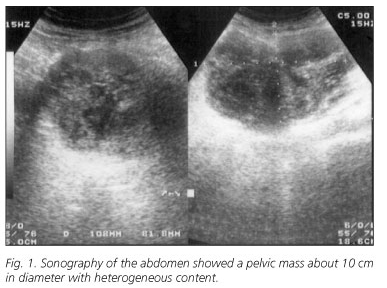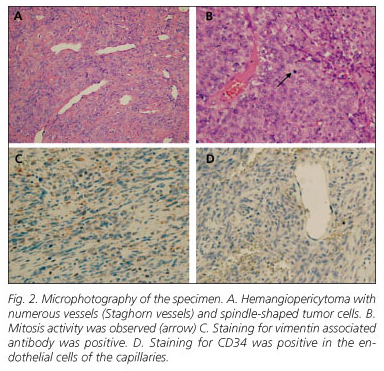Mi SciELO
Servicios Personalizados
Revista
Articulo
Indicadores
-
 Citado por SciELO
Citado por SciELO -
 Accesos
Accesos
Links relacionados
-
 Citado por Google
Citado por Google -
 Similares en
SciELO
Similares en
SciELO -
 Similares en Google
Similares en Google
Compartir
Revista Española de Enfermedades Digestivas
versión impresa ISSN 1130-0108
Rev. esp. enferm. dig. vol.102 no.5 Madrid may. 2010
LETTERS TO THE EDITOR
Unusual peritonitis: ruptured (perforated) malignant hemangiopericytoma of the sigmoid mesocolon
Peritonitis inusual: hemangiopericitoma maligno del mesocolon sigmoideo perforado
Key words: Hemangiopericytoma. Peritonitis. Pericytes. Sigmoid colon.
Dear Editor,
Hemangiopericytoma is a rare vascular soft-tissue tumor arising from the pericytes adjacent to capillaries. The tumor usually develops in the limbs, pelvic fossa, head and neck and retroperitoneum (1-3). It is rarely found in the gastrointestinal tract, especially in the colon or rectum. It has been documented in all ages, most commonly in the fifth and sixth decades (2). Surgical resection remains the optimal management clinically, and long-term survival is common in patients who receive curative resection. We report a case of malignant hemangiopericytoma in the sigmoid mesocolon presenting with peritonitis and with a good prognosis after operation.
Case report
A 75-year-old woman experienced a dull lower abdominal pain for more than six months without treatment. However, exacerbated lower abdominal pain developed several days before admission. On physical examination, a tender, movable mass was palpated in the left lower abdomen. Laboratory data revealed that the white blood cell count was 10,200/mm3, hemoglobin 11.6 μg/L, hematocrit 32.0%, sodium 135 mmol/L, and potassium 3.1 mmol/L. Sonography of the abdomen showed a pelvic mass about 10 cm in diameter with heterogeneous content (Fig. 1). As we suspected a malignancy associated with the persistent abdominal pain, the patient subsequently underwent exploration laparotomy. At laparotomy, a 10 cm diameter mass was found in the sigmoid mesocolon. A sigmoid colectomy with Hartmann's procedure was performed. The patient made an uneventful recovery after operation. No recurrence or metastasis has developed while the patient has been closely followed for two years.
Pathology of the specimen revealed a separate 11 × 10 × 10 cm lobular mass weighing 462 g within the sigmoid mesocolon. Hemorrhage and necrotic tissues were also observed. Histopathology revealed a hypercellular spindle-cell tumor with mitotic activity and necrotic phenomena. Some blood vessels were branching and exhibited a characteristic 'staghorn' configuration. Immunostaining was done with antibodies for vimentin, Ckit, CD34, actin, S100, CD10, CK, and alpha-1-antitrypsin. Immunostainings for vimentin and CD34 were positive (Fig. 2). Examination of the surgical margins confirmed complete excision and no evidence of lymph node metastases.
Discussion
In 1942, Arthur Purdy Stout and Margaret Murray coined the term "hemangiopericytoma" for a tumor derived from the cells of the outer walls of capillaries (3). It may occur anywhere, the most common location being the lower extremities, the pelvis, the head and neck and retroperitoneum (1-3). Hemangiopericytomas of the gastrointestinal tract are unusual, especially in the colon and rectum. The clinical presentation of a hemangiopericytoma is nonspecific. Obstruction, intussusception and bleeding have been reported for intestinal hemangiopericytomas (2). Pain is a late symptom related to an expanding mass. In addition, hypoglycemia caused by secretion of insulin-like growth factor or hypertension has been reported (2,4).
Histologically, hemangiopericytomas show proliferation of spindle-shaped cells around branching capillary vessels. The tumor cells originate from the pericytes found around capillaries and postcapillary venules in almost every tissue of the body. The dividing sinusoids have a "staghorn" configuration (5). Most tumors express the CD34 antigen, while others exhibit Von Willebrand factor (VIII) in the endothelial cells.
Hemangiopericytomas are classified as benign or malignant. Recent reports proposed that a malignant hemangiopericytoma is suspected for tumors larger than 5 cm showing high mitotic activity (more than four mitoses per 10 high-power fields), necrosis and hemorrhage within the tumor (2,3). The curative treatment for hemangiopericytomas is adequate surgical resection. However, tendencies for local and distant recurrences have been reported after prolonged periods. Radiotherapy and chemotherapy have been used as adjuvant therapy in cases of inadequate resection, recurrence or metastasis. Clinicians should advise the patients of the need to be carefully followed for long periods and warn them of the risk of recurrence.
C. M. Mai1,3, K. F. Hsu2, C. W. Hsiao1, C. C. Wu1, C. Y. Fu2, J. C. Yu2, J. S. Jin4 and S. W. Jao1
1Division of Colon and Rectal Surgery and 2Division of General Surgery. Department of Surgery.
Tri-Service General Hospital. National Defense Medical Center. Taipei, Taiwan. Republic of China.
3Department of Surgery. Huailien Armed Forces general Hospital. Huailien, Taiwan. Republic of China.
4Department of Pathology. Tri-Service General Hospital. National Defense Medical Center. Taipei, Taiwan. Republic of China
References
1. West NJ, Daniels IR, Allum WH. Hemangiopericytoma of the sigmoid mesentery. Tech Coloproctol 2004; 8: 179-81. [ Links ]
2. Genter B, Mir R, Strauss R, et al. Hemangiopericytoma of the colon: report of a case and review of literature. Dis Colon Rectum 1982; 25: 149-56. [ Links ]
3. Shiba H, Misawa T, Kobayashi S, et al. Hemangiopericytoma of the greater omentum. J Gastrointest Surg 2007; 11: 549-51. [ Links ]
4. Daeke DA, Lindorfer DB. Malignant retroperitoneal hemangio-pericytoma with associated hypoglycemia. Treatment via radiotherapy. Wis Med J 1974; 73: S92-6. [ Links ]
5. Ezinger & Weiss. Soft tissue tumors. 4th ed. St. Louis: Mosby; 2001. [ Links ]
















